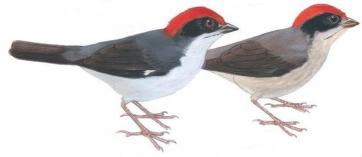
February 19, 2008

Adult and juvenile Antioquia Brush-Finches. Painted by Robin Restall
According to Donegan, T. M. 2007b. “A new species of brush finch (Emberizidae: Atlapetes) from the northern Central Andes of Colombia.” Bulletin British Ornithological Club 127: 255-268, there is a new species of Atlapetes based on the discovery of 3 old skins, one each at three different Colombian collections, previously labeled as A. schistaceus from remnant forest patches in the n. Central Andes of Colombia. Searches by Donegan and others at and near the type locality have not revealed any additional specimens. Only one of the three has a date (1971), and one of the three has no locality data other than “Antioquia.”
This new species of brush-finch has been described from museum skins labeled as Atlapetes schistaceus. The new species was given the Latin name, Atlapetes blancae. However, the plumage differences between the museum skins and A. schistaceus are significant. A. blancae is supposed to be similar to A. latinuchus elaeoprorus but significant plumage differences exist between the new species and subspecies as well. Many species are known from just museum skins, especially skins collected during colonialism when the world market was being established. Some species are described from just bones like dinosaurs.
Discovering an extant or surviving population will yield much needed data such as DNA, life history, range, and vocal recordings. Currently, the species is listed as critically endangered. This is a precautionary and practical move since Columbian forests are threatened with fragmentation and the species is known from only a few skins.
As noted by Donegan (2007), a species description based on only three skins, and without vocalizations or other observations, will always be vulnerable to skepticism, and without a DNA sample, elimination of the possibility of a hybrid population or local color morph involving the other two sympatric species is more difficult. Donegan makes a reasonable case, given the circumstances, for treating blancae as a species as the best hypothesis for the available data.

From Fundación ProAves:
Donegan said: “Hopefully, a population of the Antioquia Brush-Finch can be found and protected. It is ironic that the world’s most recently described bird species may also be among the most endangered.”
The Antioquia Brush-Finch has been proposed for “Critically Endangered” status, pending further searches.
Various sources: www.museum.lsu.edu, www.wildlifeextra.com, http://www.conservationreport.com.
About Loren Coleman
Loren Coleman is one of the world’s leading cryptozoologists, some say “the” leading living cryptozoologist. Certainly, he is acknowledged as the current living American researcher and writer who has most popularized cryptozoology in the late 20th and early 21st centuries.
Starting his fieldwork and investigations in 1960, after traveling and trekking extensively in pursuit of cryptozoological mysteries, Coleman began writing to share his experiences in 1969. An honorary member of Ivan T. Sanderson’s Society for the Investigation of the Unexplained in the 1970s, Coleman has been bestowed with similar honorary memberships of the North Idaho College Cryptozoology Club in 1983, and in subsequent years, that of the British Columbia Scientific Cryptozoology Club, CryptoSafari International, and other international organizations. He was also a Life Member and Benefactor of the International Society of Cryptozoology (now-defunct).
Loren Coleman’s daily blog, as a member of the Cryptomundo Team, served as an ongoing avenue of communication for the ever-growing body of cryptozoo news from 2005 through 2013. He returned as an infrequent contributor beginning Halloween week of 2015.
Coleman is the founder in 2003, and current director of the International Cryptozoology Museum in Portland, Maine.
Filed under Breaking News, Cryptotourism, CryptoZoo News, Cryptozoologists, Cryptozoology, Forensic Science, Museums, New Species